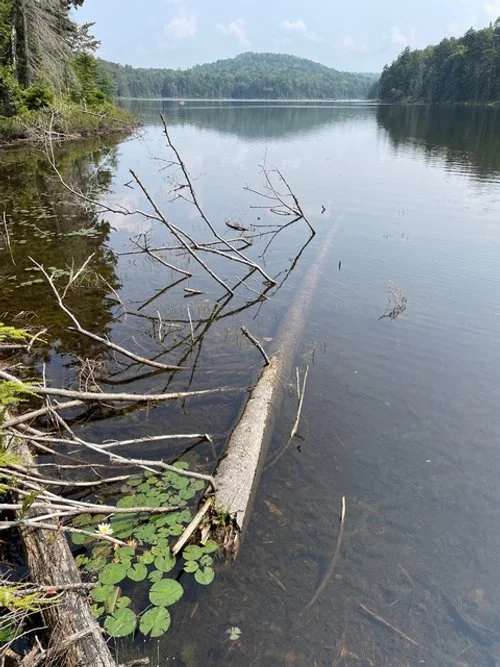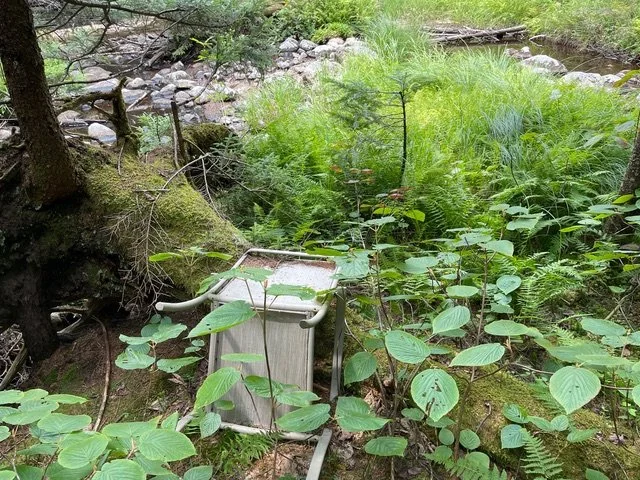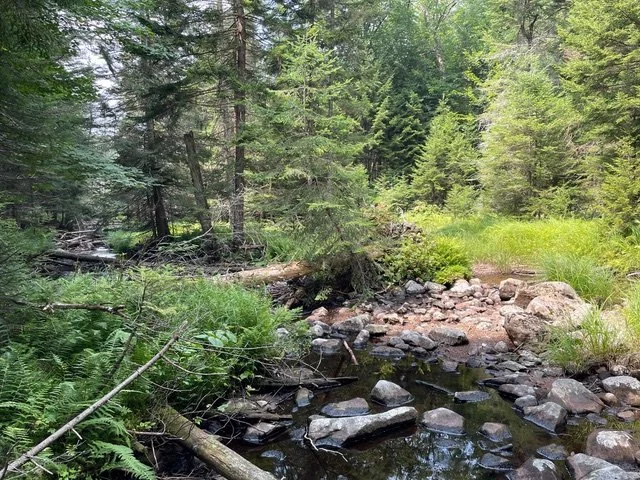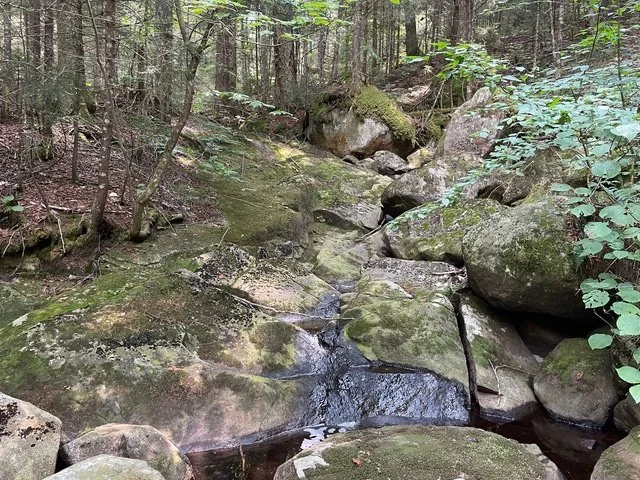Those Who Walked Before Us: Accepting the Human in the Adirondack Wilderness
Written by: Lauren Otis
Late this summer, having completed my chores and up at my family’s camp for only a few days, I opted to briefly get into the woods with a late morning stroll. I chose a familiar, well-worn route from our camp on Twitchell Lake to South Pond. South Pond is a serene, uninhabited body of water which lies between Twitchell and Big Moose Lakes inside state land at the edge of the Pigeon Lake Wilderness. Far enough away that the sounds of motor boats on both these lakes don’t carry to it, for a relatively modest effort South Pond feels far from anywhere (that is until the piercing noon siren goes off at the Big Moose fire station).
I had in mind retracing a little spur of a path I had discovered several years ago which branches off an old trail between Twitchell Road and Big Moose Lake. This not-much-used route is a legacy of the days when visitors to camps on Big Moose Lake would walk to Twitchell for a bit of woods exercise and to “take tea” at a camp here which operated an informal commissary. Technically not a state-sanctioned or maintained trail, this once regularly used route becomes harder to follow every year but still features hand-painted mileage signs in each direction and fading blazes nailed to trees.
No sign marked the spur I encountered that year however. I had only happened upon it by the outlet to South Pond when I spied an orange ribbon tied to a tree up a small rise. This ribbon led to another, and another. These informal blazes marked a not very well defined path which climbed up to and ran along the south ridge of the small glen through which flowed the outlet. That first day, from above I saw a large otter moving upstream towards South Pond. Opposite me rose an impressive sheer glacial rock face at least 15 to 20 feet in height.
The beauty of the unexpectedly encountered setting and the mystery of the amateur blazes hooked me. Each time I moved ahead a few paces along the barely discernible path, another would reveal itself. As I followed it, my guess was this path would descend to the outlet again, cross it and head back to Twitchell Road.
Ultimately, after not more than a half mile of up and down hiking, the path did descend back to the small waterway, to a lovely spot where it was met by another stream, forming the beginnings of Twitchell Creek. The blazes ended at this point, where I discovered a single chair, situated so the sitter could take in the serene opening made by this small confluence of streams.
I stood the chair up (it had been leaned over so leaves wouldn’t gather on the seat) and sat that first time. I felt I was looking at this bucolic scene not just with my own eyes, but through the eyes of that person who had come before me. He or she had thought enough of this spot, so much in fact, that they had carried a chair through the tangle of their informal trail all the way out to it. The blazes, I reasoned, were so others didn’t need this original admirer to accompany them in order to find their way to his or her spot, and chair. These blazes where a gift from the one who walked before me, an invitation to a place they had discovered and wanted to share with others.
Since my discovery, or I should say my discovery of someone else’s discovery, I’ve taken my wife and family to this spot, visiting it a half a dozen times in the ensuing years, with company and alone. After that first time, I have always left the chair leaned over and undisturbed, preferring to stand or sit on more natural spots. This recent visit, the trickle was so low due to dry conditions that I was able to clamber up the impressive tumble of rounded glacial boulders along one branch and seat myself dryly and comfortably there.
Once back home, I began reading up on the subject of “herd paths,” the informal, ostensibly illegal trails like the one I had just been on, which are found throughout wilderness areas, including the Adirondack Park.
Lengthy threads I perused on the subject went from passionate to rancorous, with some posters indignant over the presence of any human traces in wilderness areas — informal trail blazes, brush cutting and clearing along the paths — while others see such activities as inevitable and relatively harmless.
As far as I could discern, the New York State Department of Environmental Conservation and Adirondack Park Agency officially condemn the creation and blazing of unofficial paths on public wilderness land, but appear to not have the resources to counter these activities. In recent years, the NYSDEC has been compelled to address the impact of growing networks of informal trails on such “formerly trail-less” places as the summits of the high peaks of the Catskill Park as well as in the Adirondack Park’s High Peaks Wilderness.
In his book The Old Ways, Robert Macfarlane writes, “paths run through people as surely as they run through places.” This sentiment explains, I think, a lot about these paths which crisscross the Adirondack Park; that they exist within a human as well as a natural landscape. The Adirondacks are both a site of spectacular natural beauty and of centuries of history shaped by the people who lived in and traversed them. While I, like many, return to the Adirondacks year after year because of its natural beauty, wilderness which seems to stand outside of time; I also, like many, have developed a love of the history of the region, of the people who have shaped it over the course of time. Of course, many of the informal paths and trails blazed by these people from the past have become our own official state-maintained trails and routes.
“Forever wild” is such a seductive phrase that it can blind us to the reality of the Adirondack Park, where the human hand has existed since long before the visionary establishment of that Park. This fundamental tension between wilderness and the mark of humanity is inescapable and argued over passionately, not just regarding private land holdings but particularly with regard to the state preserve lands which are now deemed “forever wild.”
It could be argued and perhaps will be, that this trail I’ve encountered and enjoyed, and the chair at the end of it, is an abomination, an offense to the wilds around it (my precursor chose well, its light metal tube frame and nylon webbing appear not to have decayed much or otherwise felt the effects of time). That if I loved the Adirondack wild, I would cart back and discard the chair, even remove the blazes. Perhaps I should, but I don’t think I could ever bring myself to. Just as I would find it unthinkable to take down the trail signs and blazes put up generations ago between Twitchell and Big Moose Lakes, off which this little spur emerges. Call it respect for the human as well as natural history of my little patch of the Adirondacks; for those who walked before me.
On this most recent visit to this wilderness confluence, as it has previously, a thought crossed my mind. What if I actually encountered someone else when I descended to this hidden spot with its tipped-over chair? What if I interrupted the reveries of a stranger sitting there? It hasn’t happened and likely never will, but the fantasy of meeting the person who this path runs through, assuming they do still walk this earth, sticks in my mind. Then again, by hiking their path and contemplating the vista they first encountered, I feel I already have met them.




